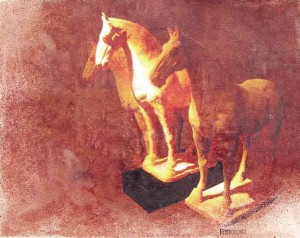
The horse’s nobility of bearing and gracefulness of movement hold deep fascination on artists through the millenniums, from the prehistoric cave dwellers to the ancient East, the Classical Greek period, the Roman antiquity, the Italian Renaissance, through the present.
One Filipino artist who consistently draws inspiration for his art from this noble form is Ramon Diaz. For years he has been mounting exhibits of series after series of paintings and drawings depicting horses in all their varying postures of beauty and power.
The latest is “Mythical Horses,” 15 pieces in oil and acrylic on canvas and in mixed media on paper, presented by Galeria Duemila until Feb. 13 on the lobby of New World Hotel, Esperanza St. cor Makati Ave., Ayala Center, Makati City.
Again, here are horses in various gaits and stances rendered chiefly in earth tones, in muted color tonality or monochrome. Their appearance eschews naturalism, as each image seems to have been carefully transferred from one medium to another.
“Celebrating the Year of the Horse has a special meaning to me,” says Diaz. “This year I have put together what I believe to be a spectacular collection of some of the rarest equine pieces. The horse is an animal that stirs my passion, respect and admiration. It represents strength, pride and beauty. It also expresses deep emotions and feelings through its beautiful measurements, stature, movement and rhythm. Horses are unlike any other animals in their capacity to unite entire peoples and cultures for progress.”
For this, he cites cultural anthropology: The horse is one of the animals that most contributed to the progress of human civilization. Over thousands of years, horses were domesticated throughout Europe, Asia and North Africa. Most of these places left beautiful artworks showing the relationship between horse and man in work, games, transport, wars, and even through religious deities. The first records of man and horse were found in Persia (Iran) from the third millennium BC, while others were discovered in Egypt and later Greece, dating back to 1580 BC.
Unique rendition
A few years ago, in his exhibit “Celestial Horses” in Galerie Astra at LRI Business Plaza in Makati City, Diaz’s rendition of the subject struck us as unique: His art appeared like one medium transferred to another medium.
For instance, a piece called “Prancing Show,” showing a forlorn animal ostensibly in an equestrian show, looked like a painting of a painted stone statue or brass sculpture of a horse mounted on a pedestal, that iconic image from Roman antiquity.
However, one shouldn’t trace the origin of Diaz’s imagery to Western art as he himself admits he draws his inspiration directly from the Orient. That textured piece could also be depicting one of those famous terra-cotta horses, or even one painted on a porcelain bowl or vase, as one can still see the paint dripping on the flank of the equine form.
A piece like “Off to the Finest Grassland,” depicting two blinding-white chargers on a blood-red field, could be an image from an ancient scroll painting.
In fact, the artist has done long research on the famous horse of the Tang Dynasty: “the graceful slope of its neck, its broad body and sturdy legs—the Tang horse, a creature of force and power, grace and movement, whose might in battle (as recounted in myths and legends) has been acclaimed by poets and painters.”
Diaz reveals: “I took a lot of inspiration from the Tang horse models excavated through the years, as well as from splendid Chinese art objects that I saw, such as pottery, decorated harnesses and statues depicting the Tang horse.”
The exhibition note reveals as much: “It was at that stage of China’s history when interest in horses was intensely pursued. Games such as polo and dressage became obsessed events in the imperial court. Emperor Xuanzong even had a stable of beautiful prancing horses that would dance and perform for court.”
Kinship with dragon
For his latest show, Diaz says he has included horses from several Chinese dynasties—Han, Zhou, Qin and Tang.
The artist has not only successfully conveyed the power and beauty of the horse but also lovingly recreated the exquisiteness of Oriental art as can be seen in the scroll paintings and ceramics of those ancient artists.
“The pride they put in their craftsmanship is something that I try to emulate in my work,” he says.
The exhibition note traces his glorification of the horse to the Asiatic’s enduring belief in the heavenly creature: “The horse’s importance in the Orient stemmed from the mythological belief that equines, like dragons, rose from the waters and had the ability to bring their riders to the land of the immortals…
“During the unification of China by the Han dynasty in 180 BC, General Zhang Qian was dispatched by Emperor Wudi to the distant Central Asian kingdom of Ferghana to seek powerful horses to secure the borders of the new empire. When he returned after establishing the Silk Route, he brought back thousands of tall equines and stories of the tianma (heavenly horses) and shenma (divine horses).”
Considering such reverence and awe accorded the creature, we find it perplexing that among artists around only Diaz seems to have seriously taken the horse as subject for art.
“In Chinese mythology, horses were believed to have kinship with the dragon,” he says. “These creatures were glorified, revered, and even deified, especially in the Tang Dynasty. In the beginning of Chinese civilization, horses with chariots were buried with deceased emperors and royalty—until they found that horses, like soldiers, were innately valuable to the survival of empires.”
Depictions of the Tang horse are said to bring good luck to the owner.